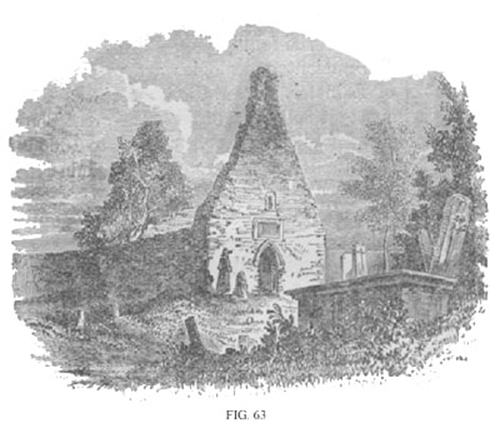Irish Histories: Genealogies: Dinnsenchus
From A Smaller Social History of Ancient Ireland 1906
« previous page | contents | start of chapter | next chapter »
CHAPTER X....concluded
4. Histories: Genealogies: Dinnsenchus.
Histories.—None of the Irish writers of old times conceived the plan of writing a general history of Ireland. The first history of the whole country was the Forus Feasa ar Erinn, or History of Ireland, from the most ancient times to the Anglo-Norman invasion, written by Dr. Geoffrey Keating of Tubbrid in Tipperary, a Catholic priest: died 1644.
FIG. 63. Tubbrid Church, the burial place of the Rev. Geoffrey Keating, as it appeared in 1845. (From Mrs. Hall's Ireland). The exact spot in this graveyard where he is interred is not known, but he is commemorated in a Latin inscription on a tablet over the door of the church (seen in the illustration).
Keating was deeply versed in the ancient language and literature of Ireland; and his history, though containing much that is legendary, is very interesting and valuable.
Genealogies.—The genealogies of the principal families were most faithfully preserved in ancient Ireland. Each king and chief had in his household a Shanachy or historian, whose duty it was to keep a written record of all the ancestors and of the several branches of the family.
Many of the ancient genealogies are preserved in the Books of Leinster, Lecan, Ballymote, &c. But the most important collection of all is the great Book of Genealogies compiled in the years 1650 to 1666 in the College of St. Nicholas in Galway, by Duald Mac Firbis.
In this place may be mentioned the Dinnsenchus [Din-Shan'ahus], a topographical tract giving the legendary history and the etymology of the names of remarkable hills, mounds, caves, carns, cromlechs, raths, duns, plains, lakes, rivers, fords, islands, and so forth. The stories are mostly fictitious—invented to suit the really existing names: nevertheless this tract is of the utmost value for elucidating the topography and antiquities of the country. Copies of it are found in several of the old Irish books of miscellaneous literature, as already mentioned.
Another very important tract—one about the names of remarkable Irish persons, called Cóir Anmann ('Fitness of Names'), corresponding with the Dinnsenchus for place-names, has been published with translation by Dr. Stokes.
END OF CHAPTER X.
« previous page | contents | start of chapter | next chapter »

